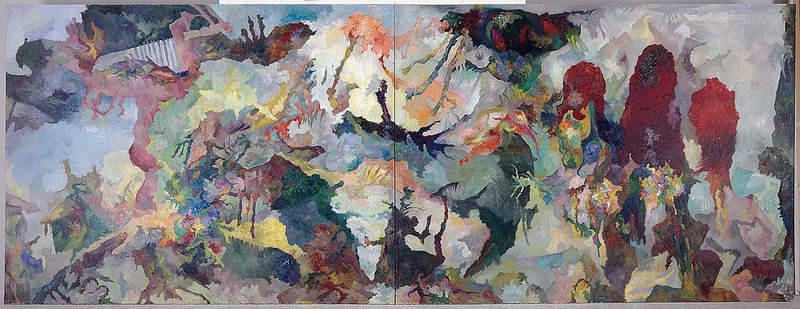Bernard Schultze
30 May - 22 Nov 2015

Bernard Schultze
Mich bedrängend, 1991
Öl auf Leinwand
220 x 520 cm
© Museum Ludwig, VG Bild-Kunst Bonn, 2015, Foto: Rheinisches Bildarchiv, Köln
Mich bedrängend, 1991
Öl auf Leinwand
220 x 520 cm
© Museum Ludwig, VG Bild-Kunst Bonn, 2015, Foto: Rheinisches Bildarchiv, Köln
BERNARD SCHULTZE
A Centennial Exhibition
30 May – 22 November 2015
Bernard Schultze (1915–2005) was a leading exponent of gestural abstract painting in Europe. In 1952 he founded the artists’ group Quadriga with Karl Otto Götz and others, ushering in Art Informel in Germany. Early in his career he adopted André Breton’s view that creative processes should be guided by the unconscious. He went on to develop an intensely personal visual vocabulary that revealed an engagement with a wide range of art historical phenomena and established him as a distinctive presence in painting and drawing.
An important part in this was played by the Migofs, mysteriously proliferating colored forms resembling living creatures that sometimes populate his expressive, yet deeply associative images. In his later years, right up to his death, in April 2005, he consistently recorded chain reactions in the painting process to produce uniquely compelling works, often on a monumental scale.
Schultze was born on 31 May 1915. The Museum Ludwig, which houses a large part of his artistic estate, is paying homage to him on the centennial of his birth with an exhibition of works from its own collection, displayed in three galleries. Along with a number of early drawings and paintings, the exhibition focuses on the last two decades of the artist’s career. The occasion is also marked by the publication by Hirmer Verlag of a catalogue raisonné of his paintings and sculptures.
Schultze was based in Cologne from 1968 until his death, in 2005. For decades he and his artist wife, Ursula, who died in 1999, were prominent figures in the cultural life of the city. His unmistakable works, with their often unusual formal inventions, were and are represented in exhibitions and museum collections in Germany and abroad.
A Centennial Exhibition
30 May – 22 November 2015
Bernard Schultze (1915–2005) was a leading exponent of gestural abstract painting in Europe. In 1952 he founded the artists’ group Quadriga with Karl Otto Götz and others, ushering in Art Informel in Germany. Early in his career he adopted André Breton’s view that creative processes should be guided by the unconscious. He went on to develop an intensely personal visual vocabulary that revealed an engagement with a wide range of art historical phenomena and established him as a distinctive presence in painting and drawing.
An important part in this was played by the Migofs, mysteriously proliferating colored forms resembling living creatures that sometimes populate his expressive, yet deeply associative images. In his later years, right up to his death, in April 2005, he consistently recorded chain reactions in the painting process to produce uniquely compelling works, often on a monumental scale.
Schultze was born on 31 May 1915. The Museum Ludwig, which houses a large part of his artistic estate, is paying homage to him on the centennial of his birth with an exhibition of works from its own collection, displayed in three galleries. Along with a number of early drawings and paintings, the exhibition focuses on the last two decades of the artist’s career. The occasion is also marked by the publication by Hirmer Verlag of a catalogue raisonné of his paintings and sculptures.
Schultze was based in Cologne from 1968 until his death, in 2005. For decades he and his artist wife, Ursula, who died in 1999, were prominent figures in the cultural life of the city. His unmistakable works, with their often unusual formal inventions, were and are represented in exhibitions and museum collections in Germany and abroad.
